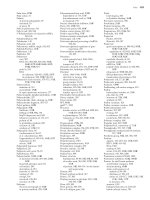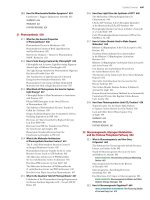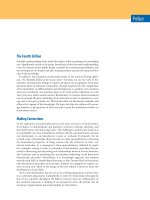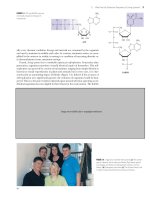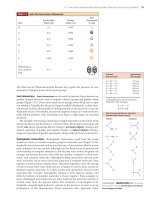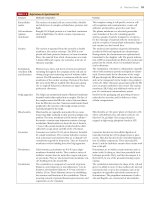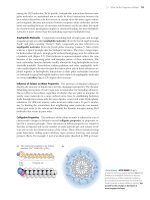Biochemistry, 4th Edition P55 ppt
Bạn đang xem bản rút gọn của tài liệu. Xem và tải ngay bản đầy đủ của tài liệu tại đây (686.32 KB, 10 trang )
16.5 How Do Bacterial Flagella Use a Proton Gradient to Drive Rotation? 503
hairpin loops of the six protein subunits form a spiral staircase, following the ssDNA as it
threads through the central pore of the hexamer (Figure 16.26).
Eric Enemark and Leemor Joshua-Tor have suggested that a central hairpin
loop from one of the AAAϩ subunits coordinates each DNA nucleotide as it enters
the helicase pore. Then, as each AAAϩ domain proceeds through the intermedi-
ate states of ATP binding and hydrolysis, its hairpin loop steps down through the
six conformations of the staircase, maintaining continuous contact with its nu-
cleotide, as it escorts it through the pore, finally releasing the nucleotide as it ex-
its the pore. Following release, the hairpin moves back to the top of the staircase,
picks up the next available nucleotide, and begins another journey down the stair-
case. For one full cycle of the hexamer, each subunit hydrolyzes one ATP, releases
one ADP, and translocates one nucleotide through the central pore. A full cycle
thus translocates six nucleotides with associated hydrolysis of six ATPs and release
of six ADPs.
16.5 How Do Bacterial Flagella Use a Proton Gradient
to Drive Rotation?
Bacterial cells swim and move by rotating their flagella. The flagella of E. coli are he-
lical filaments up to 15,000 nm (15 m) in length and 15 nm in diameter. The di-
rection of rotation of these filaments affects the movements of the cell. When the
half-dozen flagella on the surface of the bacterial cell rotate in a counterclockwise
(CCW) direction, they twist and bundle together in a left-handed helical structure
and rotate in a concerted fashion, propelling the cell through the medium. Every
few seconds, the flagellar motor reverses, the helical bundle of filaments (now turn-
ing clockwise, or CW) unwinds into a jumble, and the bacterium somersaults or
tumbles. Alternating between CCW and CW rotations, the bacterium can move to-
ward food sources, such as amino acids and sugars.
The rotations of bacterial flagellar filaments are the result of the rotation of
motor protein complexes in the bacterial plasma membrane.
(a) (b)
FIGURE 16.26 The hairpin loops of the E1 helicase hexamer are arranged in a spiral staircase that winds around
the DNA strand (a) side view; (b) axial view (pdb id ϭ 2GXA). As the helicase moves along the strand, the hair-
pin loop of one protein monomer binds each nucleotide as it enters the central cavity of the helicase.The loop
adopts six conformations (a) as the helicase moves along the DNA, preserving the loop–nucleotide interaction
until the nucleotide exits the cavity.The released protein loop then returns to the other end of the cavity to
bind a new, incoming nucleotide. DNA is shown as a stick structure. His
507
of each hairpin loop is shown in
space-filling mode.
504 Chapter 16 Molecular Motors
LP rings
FlgI, FlgH
Outer membrane
Cell membrane
Cytoplasm
Peptidogylcan
layer (cell wall)
Hook
FlgE
L
P
S
M
MS rings
FliF, FliG
C ring
FliM, FliN
and FliG
Cap FliD
Filament
(Flagellin)
The Flagellar Rotor Is a Complex Structure
The flagellum is built from at least 25 proteins and comprises three parts: a rotary
motor anchored in the bacterial inner membrane, a long filament that serves as a
helical propellor, and a “hook” that functions as a universal joint that connects the
motor with the filament (Figure 16.27). The rotary motor includes several rings of
protein subunits, including the C ring, the MS ring, the P ring, and the L ring. The
MS ring is built from 26 copies of the protein FliF. The C ring is attached to the MS
ring and includes three “rotor” proteins—FliG, FliM, and FliN—involved in rota-
tion of the motor. The C ring includes 26 copies of FliG, 34 copies of FliM, and
34 ϫ 4 ϭ 136 copies of FliN. The stationary portion of the motor—the “stator”—is
formed from the proteins motA and motB. Eight motA
4
–motB
2
complexes are em-
bedded in the bacterial inner membrane around the MS ring.
Gradients of H
؉
and Na
؉
Drive Flagellar Rotors
What energy source drives the flagellar motor? Gradients of protons and Na
ϩ
ions
exist across bacterial inner membranes, typically with more H
ϩ
and Na
ϩ
outside
the cell. In E. coli, spontaneous inward flow of protons through the motA–motB
complexes drives the rotation of the motor (Figure 16.28). In Vibrio cholerae, inward
Na
ϩ
ion flow powers the motor. Flagellar motors are thus energy conversion de-
vices. In E. coli, each motA–motB complex passes 70 H
ϩ
per revolution of the mo-
tor. With a full complement of eight motA–motB complexes, a motor conducts
about 560 protons per revolution. The H
ϩ
-driven flagellar rotors reach top rota-
tional speeds of about 360 Hz (corresponding to 21,600 rpm). Thus, the overall
rate of proton flow for the motor is approximately 200,000 H
ϩ
/sec! Flagellar mo-
tors driven by Na
ϩ
ions are even faster, with rotational rates of 1700 Hz (100,000
rpm) observed in Vibrio.
The motA–motB complexes work with FliG in the C ring to transfer protons
across the membrane. FliG contains 335 residues, and most of the FliG protein
structure (residues 104 to 335) consists of two compact domains joined by an
␣-helix (Figure 16.28). A ridge on the C-terminal domain contains five charged
residues that interact with motA and are important for motor rotation. Asp
32
of
motB is essential for rotation of the motor and is probably involved in proton trans-
fer. David Blair has proposed a model for creation of two membrane channels from
the transmembrane segments of the motA
4
–motB
2
complex. Blair has suggested
that each encounter of a motA–motB complex with a FliG subunit as the motor
turns results in movement of one proton through each of these channels. The pas-
sage of about 70 H
ϩ
through each motA–motB complex in one revolution of the
FIGURE 16.27 A model of the E. coli flagellar motor.The motor
is anchored by interactions of stationary motA and motB
proteins in the M and S rings with the inner membrane.
Spontaneous flow of protons through the motA–motB com-
plexes and into the cell drives the rotation of the motor. Flow
rates of 200,000 protons per second drive the motor at
speeds approaching 22,000 rpm. (Adapted from Thomas, D. R.,
Morgan, D. G., Francis, N. R., and DeRosier, D. J., 2007. Bit by bit the struc-
ture of the complete flagellar hook/basal body complex. Microscopy
and Microanalysis 13:34–35.Image provided by David J. DeRosier,
Brandeis University.)
16.5 How Do Bacterial Flagella Use a Proton Gradient to Drive Rotation? 505
motor (which would involve encounters with 34 FliG subunits) is consistent with
this suggestion (70/34 ϭ ϳ2).
The Flagellar Rotor Self-Assembles in a Spontaneous Process
Flagellar rotors are true masterpieces of biological self-assembly. The ring of FliF
subunits, within the MS ring, is the first to assemble in the plasma membrane. Other
proteins then attach to this ring one after another, from the base to the tip, to con-
struct the motor structure. Once the motor has formed, the flexible hook and the
flagellar filament are assembled. Precise recognition of the existing template struc-
ture allows this highly ordered self-assembly process to proceed without error. The
flagellar filament is made from 20,000 to 30,000 copies of flagellin polymerized into
a hollow helical tube structure. Each turn of the helical filament contains about
5000 flagellin subunits and is about 2300 nm long. A complete flagellum can have
up to six full helical turns. Flagellin molecules are transported through the long,
narrow, central channel of the motor and flagellum from the cell interior to the far
end of the flagellum, where they self-assemble with the help of a pentameric com-
plex of FliD, a capping protein (see Figure 16.27). The FliD complex has a plate
and five leg domains. It rotates in a stepping fashion at the end of the filament, ex-
posing one binding site at a time and guiding the binding of newly arriving flagellin
molecules in a helical pattern.
Flagellar Filaments Are Composed of Protofilaments of Flagellin
Each cylindrical flagellar filament is composed of 11 fibrils or protofilaments that
form the cylinder, with each fibril lying at a slight tilt to the cylinder axis (Figure
16.29a). An end-on view of the filament shows 11 subunits, each representing the
end of a protofilament (Figure 16.29b). The flagellin protein of Salmonella typhi-
؊؊؉؊؊؉
MotA
؉؊؊؉؊؊
FliG
middle
domain
Gly-Gly
FliG
C-terminal
domain
FliM
MS ring
MotA
Membrane
MotB
K
262
D
288
D
289
R
297
R
281
FIGURE 16.28 Interactions between the stationary
motA–motB complexes and the rotating FliG ring drive
the flagellar motor. Proton flow through the motA–motB
complexes is presumably coupled to conformation
changes that alter ionic interactions between charged
residues at the motA–motB and FliG interface, driving
rotation of the FliG ring.Other conserved features
include a hydrophobic patch (light green), a Gly-Gly
motif (purple), and a EHPQR motif (blue, in the middle
domain (pdb id ϭ 1LKV).
506 Chapter 16 Molecular Motors
murium contains 494 residues and consists of four domains, denoted D0 through D3
(Figure 16.29c). D0 and D1 are composed of ␣-helices, whereas D2 and D3 consist
primarily of -strands. The N-terminus of the peptide chain lies at the base of D0.
The peptide runs from D0 to D3 and then reverses and returns to D0, where the
N- and C-termini are juxtaposed. The structure resembles a Greek capital gamma
(⌫), with a height of 140 Å and a width of 110 Å. Each flagellin protein is arranged
with D0 inside the filament and D3 facing the outside. The central pore, 20 Å in
diameter, is lined by the ␣-helices of D0.
Motor Reversal Involves Conformation Switching of Motor
and Filament Proteins
The flagellar motor reverses direction every few seconds so that the bacterium
can change its swimming direction to seek better environments. Motor reversal
involves conformation changes both in motor proteins and also in the filament
itself. In the motor structure, the rotor proteins FliG, FliM, and FliN work to-
gether to control direction changes of the motor, and they are known collectively
as the switch complex. FliN appears to lie at the base of the C ring, FliG lies at
the top of the C ring, and FliM resides in the middle, contacting both FliN and
FliG (Figure 16.30).
Reversal of the flagellar motor causes the long filament to switch from a left-
handed helical structure to a right-handed helical form. This makes the bundle of
flagella fall apart, causing the bacterium to tumble. This left–to–right switch in the
filament is caused by a conformational change that occurs in the flagellin subunits
in some protofilaments. Interestingly, the driving force for these conformation
changes is probably the torque applied to D0 and D1 of flagellin subunits along the
filament when the motor itself reverses.
D0
D0
D1
D1
(a) (b)
D2
D2
D3
D3
S
D0
D1
D2
D3
S
D1
(c)
N
C
D2
D3
D0
FIGURE 16.29 The E. coli flagellum is composed of 11 protofilaments that run the length of the flagellar fila-
ment.The filament is shown in cross section (a) and perpendicular to the filament (b). The protofilaments are
long polymers of the flagellin protein (c), which consists of two ␣-helical domains (D0 and D1) that lie at a
slight tilt to the filament axis and two -sheet domains (D2 and D3) that extend outward from the filament.
The N- and C-termini of the polypeptide are indicated (pdb id ϭ 1UCU). (Parts (a) and (b) courtesy of Keiichi Namba,
Osaka University, Japan.)
Summary 507
FliG
FliM
FliN
FliG
FliN
FliM
FIGURE 16.30 The switch complex that controls direction changes by the flagellar
rotor consists of the rotor proteins FliG, FliM, and FliN. Interactions between these
three proteins are presumed to control the direction of the rotor. Direction changes
initiated here are communicated by protein conformation changes across the motor
complex and throughout the length of the filament. Self-association of FliM subunits is
mediated by hydrophilic residues of the ␣1 helix (red) on one subunit and on a short helix
and loop on the adjacent subunit. Juxtaposed FliN subunits in the ring form a hydropho-
bic cleft (yellow). (FliG: pdb id ϭ 1LKV; FliM: pdb id ϭ 2HP7; FliN: pdb id ϭ 1YAB.) (Image on
left courtesy of David J. DeRosier, Brandeis University.)
SUMMARY
16.1 What Is a Molecular Motor? Motor proteins, also known as mol-
ecular motors, use chemical energy (ATP) to orchestrate different
movements, transforming ATP energy into the mechanical energy of
motion. In all cases, ATP hydrolysis is presumed to drive and control
protein conformational changes that result in sliding or walking move-
ments of one molecule relative to another. To carry out directed move-
ments, molecular motors must be able to associate and dissociate
reversibly with a polymeric protein array, a surface, or substructure in
the cell. ATP hydrolysis drives the process by which the motor protein
ratchets along the protein array or surface. Molecular motors may be
linear or rotating. Linear motors crawl or creep along a polymer lattice,
whereas rotating motors consist of a rotating element (the “rotor”) and
a stationary element (the “stator”), in a fashion much like a simple elec-
trical motor.
508 Chapter 16 Molecular Motors
16.2 What Is the Molecular Mechanism of Muscle Contraction? Exam-
ination of myofibrils in the electron microscope reveals a banded or stri-
ated structure. The so-called H zone shows a regular, hexagonally
arranged array of thick filaments, whereas the I band shows a regular,
hexagonal array of thin filaments. In the dark regions at the ends of each
A band, the thin and thick filaments interdigitate. The thin filaments are
composed primarily of three proteins called actin, troponin, and tropo-
myosin. The thick filaments consist mainly of a protein called myosin.
The thin and thick filaments are joined by cross-bridges. These cross-
bridges are actually extensions of the myosin molecules, and muscle con-
traction is accomplished by the sliding of the cross-bridges along the thin
filaments, a mechanical movement driven by the free energy of ATP
hydrolysis.
Myosin, the principal component of muscle thick filaments, is a large
protein consisting of six polypeptides, including light chains and heavy
chains. The heavy chains consist of globular amino-terminal myosin
heads, joined to long ␣-helical carboxy-terminal segments, the tails.
These tails are intertwined to form a left-handed coiled coil approxi-
mately 2 nm in diameter and 130 to 150 nm long. The myosin heads
exhibit ATPase activity, and hydrolysis of ATP by the myosin heads drives
muscle contraction.
The free energy of ATP hydrolysis is translated into a conformation
change in the myosin head, so dissociation of myosin and actin, hydro-
lysis of ATP, and rebinding of myosin and actin occur with stepwise
movement of the myosin S1 head along the actin filament. The confor-
mation change in the myosin head is driven by the hydrolysis of ATP.
16.3 What Are the Molecular Motors That Orchestrate the Mechano-
chemistry of Microtubules? Microtubules are hollow, cylindrical struc-
tures, approximately 30 nm in diameter, formed from tubulin, a dimeric
protein composed of two similar 55-kD subunits known as ␣-tubulin and
-tubulin. Tubulin dimers polymerize to form microtubules, which are es-
sentially helical structures, with 13 tubulin monomer “residues” per turn.
Microtubules are, in fact, a significant part of the cytoskeleton, a sort of in-
tracellular scaffold formed of microtubules, intermediate filaments, and
microfilaments. In most cells, microtubules are oriented with their minus
ends toward the centrosome and their plus ends toward the cell periphery.
This consistent orientation is important for mechanisms of intracellular
transport. Microtubules are also the fundamental building
blocks of eu-
karyotic cilia and flagella. Microtubules also mediate the intracellular mo-
tion of organelles and vesicles.
16.4 How Do Molecular Motors Unwind DNA? When DNA is to be
replicated or repaired, the strands of the double helix must be unwound
and separated to form single-stranded DNA intermediates. This separa-
tion is carried out by molecular motors known as DNA helicases that
move along the length of the DNA lattice, sequentially destabilizing the
hydrogen bonds between complementary base pairs. The movement
along the lattice and the separation of the DNA strands are coupled to
the hydrolysis of nucleoside 5Ј-triphosphates. The E. coli BCD helicase,
which is involved in recombination processes, can unwind 33,000 base
pairs before it dissociates from the DNA lattice. Processive movement is
essential for helicases involved in DNA replication, where millions of
base pairs must be replicated rapidly. Certain hexameric helicases form
ringlike structures that completely encircle at least one of the strands of
a DNA duplex. Other helicases, notably Rep helicase from E. coli, are
homodimeric and move processively along the DNA helix by means of a
“hand-over-hand” movement that is remarkably similar to that of ki-
nesin’s movement along microtubules.
16.5 How Do Bacterial Flagella Use a Proton Gradient to Drive Rotation?
Bacterial cells swim and move by rotating their flagella. The direction of
rotation of these flagella affects the movements of the cell. When the half-
dozen flagella on the surface of the bacterial cell rotate in a counter-
clockwise direction, they twist and bundle together and rotate in a con-
certed fashion, propelling the cell through the medium. The rotations of
bacterial flagellar filaments are the result of the rotation of motor protein
complexes in the bacterial plasma membrane. The flagellar motor con-
sists of multiple rings (including the MS ring and the C ring). The rings
are surrounded by a circular array of membrane proteins. In all, at least
40 genes appear to code for proteins involved in this magnificent assem-
bly. One of these, the motB protein, lies on the edge of the M ring, where
it interacts with the motA protein, located in the membrane protein array
and facing the M ring. In contrast to the many other motor proteins de-
scribed in this chapter, a proton gradient, not ATP hydrolysis, drives the
flagellar motor.
PROBLEMS
Preparing for an exam? Create your own study path for this
chapter at www.cengage.com/login.
1. The cheetah is generally regarded as nature’s fastest mammal, but
another amazing athlete in the animal kingdom (and almost as fast
as the cheetah) is the pronghorn antelope, which roams the plains
of Wyoming. Whereas the cheetah can maintain its top speed of
70 mph for only a few seconds, the pronghorn antelope can run at
60 mph for about an hour! (It is thought to have evolved to do so
in order to elude now-extinct ancestral cheetahs that lived in North
America.) What differences would you expect in the muscle struc-
ture and anatomy of pronghorn antelopes that could account for
their remarkable speed and endurance?
2. An ATP analog, ,␥-methylene-ATP, in which a OCH
2
O group re-
places the oxygen atom between the - and ␥-phosphorus atoms, is a
potent inhibitor of muscle contraction. At which step in the contrac-
tion cycle would you expect ,␥-methylene-ATP to block contraction?
3. ATP stores in muscle are augmented or supplemented by stores of
phosphocreatine. During periods of contraction, phosphocreatine
is hydrolyzed to drive the synthesis of needed ATP in the creatine
kinase reaction:
Phosphocreatine ϩ ADP⎯⎯→creatine ϩ ATP
Muscle cells contain two different isozymes of creatine kinase, one
in the mitochondria and one in the sarcoplasm. Explain.
4. Rigor is a muscle condition in which muscle fibers, depleted of ATP
and phosphocreatine, develop a state of extreme rigidity and can-
not be easily extended. (In death, this state is called rigor mortis, the
rigor of death.) From what you have learned about muscle contrac-
tion, explain the state of rigor in molecular terms.
5. Skeletal muscle can generate approximately 3 to 4 kg of tension or
force per square centimeter of cross-sectional area. This number is
roughly the same for all mammals. Because many human muscles
have large cross-sectional areas, the force that these muscles can
(and must) generate is prodigious. The gluteus maximus (on which
you are probably sitting as you read this) can generate a tension of
1200 kg! Estimate the cross-sectional area of all of the muscles in
your body and the total force that your skeletal muscles could gen-
erate if they all contracted at once.
6. Calculate a diameter for a tubulin monomer, assuming that the mono-
mer MW is 55,000, that the monomer is spherical, and that the den-
sity of the protein monomer is 1.3 g/mL. How does the number that
you calculate compare to the dimension portrayed in Figure 16.12?
7. Use the number you obtained in problem 6 to calculate how many
tubulin monomers would be found in a microtubule that stretched
across the length of a liver cell. (See Table 1.2 for the diameter of a
liver cell.)
8. The giant axon of the squid may be up to 4 inches in length. Use
the value cited in this chapter for the rate of movement of vesicles
Further Reading 509
and organelles across axons to determine the time required for a
vesicle to traverse the length of this axon.
9. As noted in this chapter, the myosin molecules in thick filaments of
muscle are offset by approximately 14 nm. To how many residues of
a coiled-coil structure does this correspond?
10. Use the equations of Chapter 9 to determine the free energy dif-
ference represented by a Ca
2ϩ
gradient across the sarcoplasmic
reticulum membrane if the luminal (inside) concentration of
Ca
2ϩ
is 1 mM and the concentration of Ca
2ϩ
in the solution
bathing the muscle fibers is 1 M.
11. Use the equations of Chapter 3 to determine the free energy of hy-
drolysis of ATP by the sarcoplasmic reticulum Ca-ATPase if the con-
centration of ATP is 3 mM, the concentration of ADP is 1 mM, and
the concentration of P
i
is 2 mM.
12. Under the conditions described in problems 10 and 11, what is the
maximum number of Ca
2ϩ
ions that could be transported per ATP
hydrolyzed by the Ca-ATPase?
13. For each of the motor proteins in Table 16.2, calculate the force ex-
erted over the step size given, assuming that the free energy of hy-
drolysis of ATP under cellular conditions is Ϫ50 kJ/mol.
14. When you go to the gym to work out, you not only exercise many
muscles but also involve many myosins (and actins) in any given ex-
ercise activity. Suppose you lift a 10-kg weight a total distance of
0.4 m. Using the data in Table 16.2 for myosin, calculate the mini-
mum number of myosin heads required to lift this weight and the
number of sliding steps these myosins must make along their asso-
ciated actin filaments.
15. In which of the following tissues would you expect to find smooth
muscle?
a. Arteries
b. Stomach
c. Urinary bladder
d. Diaphragm
e. Uterus
f. The gums in your mouth
16. When an action potential (nerve impulse) arrives at a muscle mem-
brane (sarcolemma), in what order do the following events occur?
a. Release of Ca
2ϩ
ions from the sarcoplasmic reticulum
b. Hydrolysis of ATP, with release of energy
c. Detachment of myosin from actin
d. Sliding of myosin along actin filament
e. Opening of switch 1 and switch 2 on myosin head
17. (Essay question.) You are invited by the National Science Founda-
tion to attend a scientific meeting to set the agenda for funding of
basic research related to molecular motors for the next 10 years.
Only basic research will be funded, ruling out studies on human
subjects. You are asked to suggest the research area most worthy of
scientific research. Your presentation must include (1) a brief back-
ground on what we currently know about the subject; (2) identifi-
cation of a key research topic about which more needs to be known;
and (3) a justification of why additional knowledge in this area is
critical for advancing the field (that is, why investigations in this
area are especially important). You are not being asked to provide
the methods or experiments that might be used to address the
problem—only the concept. Base your presentation on what you
have learned in this chapter (you may consult and include refer-
ences from the Further Reading section), and limit your presenta-
tion to 300 words.
Preparing for the MCAT Exam
18. Consult Figure 16.17 and use the data in problem 8 to determine
how many steps a kinesin motor must take to traverse the length of
the squid giant axon.
19. When athletes overexert themselves on hot days, they often suffer
immobility from painful muscle cramps. Which of the following is
a reasonable hypothesis to explain such cramps?
a. Muscle cells do not have enough ATP for normal muscle relax-
ation.
b. Excessive sweating has affected the salt balance within the muscles.
c. Prolonged contractions have temporarily interrupted blood flow
to parts of the muscle.
d. All of the above.
20. Duchenne muscular dystrophy is a sex-linked recessive disorder
associated with severe deterioration of muscle tissue. The gene for
the disease:
a. is inherited by males from their mothers.
b. should be more common in females than in males.
c. both a and b.
d. neither a nor b.
FURTHER READING
Muscle Contraction
Bagshaw, C. R., 2007. Myosin mechanochemistry. Structure 15:511–512.
Coureux, P D., Sweeney, H. L., et al., 2004. Three myosin V structures
delineate essential features of chemo-mechanical transduction.
EMBO Journal 23:4527–4537.
Fischer, S., Windshugel, B., et al., 2005. Structural mechanism of the re-
covery stroke in the myosin molecular motor. Proceedings of the Na-
tional Academy of Sciences U.S.A. 102:6873–6878.
Geeves, M. A., and Holmes, K. C., 2005. The molecular mechanism of
muscle contraction. Advances in Protein Chemistry 71:161–193.
Kintses, B., Gyimesi, M., et al., 2007. Reversible movement of switch 1
loop of myosin determines action interaction. EMBO Journal 26:
265–274.
Piazzesi, G., Reconditi, M., et al., 2007. Skeletal muscle performance de-
termined by modulation of number of myosin motors rather than
motor force or stroke size. Cell 131:784–795.
Yang, Y., Gourinath, S., et al., 2007. Rigor-like structures from muscle
myosins reveal key mechanical elements in the transduction path-
ways of this allosteric motor. Structure 15:553–564.
Dystrophin and Muscular Dystrophy
Davies, K. E. and Nowak, K. J., 2006. Molecular mechanisms of muscu-
lar dystrophies: Old and new players. Nature Reviews Molecular Cell
Biology 7:762–773.
Kinesins
Alonso, M. C., Drummond, D. R., et al., 2007. An ATP gate controls tubu-
lin binding by the tethered head of kinesin-1. Science 316:120–123.
Asbury, C. L., 2005. Kinesin: World’s tiniest biped. Current Opinion in
Structural Biology 17:89–97.
Carter, N. J., and Cross, R. A., 2005. Mechanics of the kinesin step. Na-
ture 435:308–312.
Carter, N. J., and Cross, R. A., 2006. Kinesin’s moonwalk. Current Opin-
ion in Structural Biology 18:71–67.
Lakamper, S., and Meyhofer, E., 2006. Back on track—On the role of
the microtubule for kinesin motility and cellular function. Journal of
Muscle Research and Cell Motility 27:161–171.
Marx, A., Muller, J., et al., 2006. Interaction of kinesin motors, micro-
tubules, and MAPs. Journal of Muscle Research and Cell Motility 27:
135–137.
Marx, A., Muller, J., et al., 2005. The structure of microtubule motor
proteins. Advances in Protein Chemistry 71:299–344.
Moores, C. A., and Milligan, R. A., 2006. Lucky 13: Microtubule depoly-
merization by kinesin-13 motors. Journal of Cell Science 119:3905–3913.
Skowronek, K. J., Kocik, E., et al., 2007. Subunits interactions in kinesin
motors. European Journal of Cell Biology 86:559–568.
Tan, D., Asenjo, A. B., et al., 2006. Kinesin-13s form rings around micro-
tubules. Journal of Cell Biology 175:25–31.
510 Chapter 16 Molecular Motors
Yildiz, A., and Selvin, P. R., 2005. Kinesin: Walking, crawling or sliding
along? Trends in Cell Biology 15:112–120.
Dyneins
Cross, R. A., 2004. Molecular motors: Dynein’s gearbox. Current Biology
14:R355–R356.
Gross, S. P., Vershinin, M., et al., 2007. Cargo transport: Two motors are
sometimes better than one. Current Biology 17:R478–R486.
Mallik, R., Carter, B. C., et al., 2004. Cytoplasmic dynein functions as a
gear in response to load. Nature 427:649–652.
Oiwa, K., and Sakakibara, H., 2005. Recent progress in dynein structure
and mechanism. Current Opinion in Cell Biology 17:98–103.
Serohijos, A. W. R., Chen, Y., et al., 2006. A structural model reveals
energy transduction in dynein. Proceedings of the National Academy of
Sciences U.S.A. 103:18540–18545.
Toba, S., Watanabe, T. M., et al., 2006. Overlapping hand-over-hand
mechanism of single molecular motility of cytoplasmic dynein. Pro-
ceedings of the National Academy of Sciences U.S.A. 103:5741–5745.
Intermediate Filaments
Caviston, J. P., and Holzbaur, E. L., 2006. Microtubule motors at the inter-
section of trafficking and transport. Trends in Cell Biology 16:530–537.
Chou, Y-H., Flitney, F. W., et al., 2007. The motility and dynamic prop-
erties of intermediate filaments and their constituent proteins. Ex-
perimental Cell Research 313:2236–2243.
Helfand, B. T., Chang, L., et al., 2004. Intermediate filaments are dy-
namic and motile elements of cellular architecture. Journal of Cell
Science 117:133–141.
Hirokawa, N., 2006. mRNA transport in dendrites: RNA granules, mo-
tors, and tracks. Journal of Neuroscience 26:7139–7142.
Hirokawa, N., and Takemura, R., 2005. Molecular motors and mecha-
nisms of directional transport in neurons. Nature Reviews Neuro-
science 6:201–214.
Michie, K., and Lowe, J., 2006. Dynamic filaments of the bacterial cyto-
skeleton. Annual Review of Biochemistry 75:467–492.
Styers, M., Kawalczyk, A. P., et al., 2007. Intermediate filaments and
vesicular membrane traffic: The odd couple
’s first dance? Traffic
6:359–365.
Tekotte, H., and Davis, I., 2002. Intracellular mRNA localization: Motors
move messages. Trends in Genetics 18:636–642.
Vale, R. D., 2003. The molecular motor toolbox for intracellular trans-
port. Cell 112:467–480.
Vale, R. D., and Milligan, R. A., 2000. The way things move: Looking un-
der the hood of molecular motor proteins. Science 288:88–95.
Verhey, K. J., and Gaertig, J., 2007. The tubulin code. Cell Cycle
6:2152–2160.
Helicases
Castella, S., Bingham, G., et al., 2006. Common determinants in DNA
melting and helicase-catalyzed DNA unwinding by papillomavirus
replication protein E1. Nucleic Acids Research 34:3008–3019.
Enemark, E. J., and Joshua-Tor, L., 2006. Mechanism of DNA transloca-
tion in a replicative hexameric helicase. Natur
e 442:270–275.
Georgescu, R. E., and O’Donnell, M., 2007. Getting DNA to unwind.
Science 317:1181–1182.
Ha, T., 2007. Need for speed: Mechanical regulation of a replicative he-
licase. Cell 129:1249–1250.
Hanson, P. I., and Whiteheart, S. W., 2005. AAAϩ proteins: Have en-
gine, will work. Nature Reviews Molecular Cell Biology 6:519–529.
Johnson, D. S., Bai, L., et al., 2007. Single-molecule studies reveal dy-
namics of DNA unwinding by the ring-shaped T7 helicase. Cell 129:
1299–1309.
Massey, T. H., Mercogliano, C. P., et al., 2006. Double-stranded DNA
translocation: Structure and mechanism of hexameric FtsK. Molecu-
lar Cell 23:457–469.
Okorokov, A. L., Waugh, A., et al., 2007. Hexameric ring
structure of hu-
man MCM10 DNA replication factor. EMBO Reports 8:925–930.
Raney, K. D., 2006. A helicase staircase. Nature Structural and Molecular
Biology 13:671–672.
Sakato, M., and King, S. M., 2003. Design and regulation of the AAAϩ
microtubule motor dynein. Journal of Structural Biology 146:58–71.
Singleton, M. R., Dillingham, M. S., et al., 2007. Structure and mecha-
nism of helicases and nucleic acid translocases. Annual Review of Bio-
chemistry 76:23–50.
Flagellar Rotor
Brown, P. N., Terrazas, M., et al., 2007. Mutational analysis of the flagel-
lar protein FliG: Sites of interaction with FliM and implications for
organization of the switch complex. Journal of Bacteriology 189:
305–312.
Dyer, C., and Dahlquist, F. W., 2006. Switched or not? The structure of
unphosphorylated CheY bound to the N-terminus of FliM. Journal
of Bacteriology 188:7354–7363.
Hosking, E. R., Vogt, C., et al., 2006. The Escherichia coli motAB proton
channel unplugged. Journal of Molecular Biology 364:921–937.
Kitao, A., Yonekura, K., et al., 2006. Switch interactions control energy
frustration and multiple flagellar filament structures. Proceedings of
the National Academy of Sciences U.S.A. 103:4894–4899.
Park, S-Y., Lowder, B., et al., 2006. Structure of FliM provides insight into
assembly of the switch complex in the bacterial flagella motor. Pro-
ceedings of the National Academy of Sciences U.S.A. 103:11886–11891.
Van den Heuvel, M. G. L., and Dekker, C., 2007. Motor proteins at work
for nanotechnology. Science 317:333–336.
Wadhams, G. H., and Armitage, J. P., 2004. Making sense of it all: Bac-
terial chemotaxis. Nature Reviews Molecular Cell Biology 5:1024–1037.
Waters, R. C., O’Toole, P. W., et al., 2007. The FliK protein and fla
gellar
hook-length control. Protein Science 16:769–780.
Xing, J., Bai, F., et al., 2006. Torque–speed relationship of the bacterial
flagellar motor. Pr
oceedings of the National Academy of Sciences U.S.A.
103:1260–1265.
Yakushi, T., Yang, J., et al., 2006. Roles of charged residues of rotor and
stator in flagellar rotation: Comparative study using H
ϩ
-driven and
Na
ϩ
-driven motors in Escherichia coli. Journal of Bacteriology 188:
1466–1472.
© Gray Hardel/CORBIS
17
Metabolism: An Overview
17.1 Is Metabolism Similar in Different Organisms?
One of the great unifying principles of modern biology is that organisms show marked
similarity in their major pathways of metabolism. Given the almost unlimited possibil-
ities within organic chemistry, this generality would appear most unlikely. Yet it’s true,
and it provides strong evidence that all life has descended from a common ancestral
form. All forms of nutrition and almost all metabolic pathways evolved in early prokary-
otes prior to the appearance of eukaryotes 1 billion years ago. For example, glycolysis,
the metabolic pathway by which energy is released from glucose and captured in the
form of ATP under anaerobic conditions, is common to almost every cell. It is believed
to be the most ancient of metabolic pathways, having arisen prior to the appearance
of oxygen in abundance in the atmosphere. All organisms, even those that can syn-
thesize their own glucose, are capable of glucose degradation and ATP synthesis via gly-
colysis. Other prominent pathways are also virtually ubiquitous among organisms.
Living Things Exhibit Metabolic Diversity
Although most cells have the same basic set of central metabolic pathways, different
cells (and, by extension, different organisms) are characterized by the alternative
pathways they might express. These pathways offer a wide diversity of metabolic pos-
sibilities. For instance, organisms are often classified according to the major meta-
bolic pathways they exploit to obtain carbon or energy. Classification based on
carbon requirements defines two major groups: autotrophs and heterotrophs.
Autotrophs are organisms that can use just carbon dioxide as their sole source of
carbon. Heterotrophs require an organic form of carbon, such as glucose, in order
to synthesize other essential carbon compounds.
Classification based on energy sources also gives two groups: phototrophs and
chemotrophs. Phototrophs are photosynthetic organisms, which use light as a source of
energy. Chemotrophs use organic compounds such as glucose or, in some instances,
oxidizable inorganic substances such as Fe
2ϩ
, NO
2
Ϫ
, NH
4
ϩ
, or elemental sulfur as sole
sources of energy. Typically, the energy is extracted through oxidation–reduction re-
actions. Based on these characteristics, every organism falls into one of four categories
(Table 17.1).
Metabolic Diversity Among the Five Kingdoms Prokaryotes (the kingdom
Monera—archaea and bacteria) show a greater metabolic diversity than all the
Anise swallowtail butterfly (Papilio zelicans) with its
pupal case. Metamorphosis of butterflies is a dra-
matic example of metabolic change.
All is flux, nothing stays still.
Nothing endures but change.
Heraclitus (c. 540–c. 480 B.C.)
KEY QUESTIONS
17.1 Is Metabolism Similar in Different
Organisms?
17.2 What Can Be Learned from Metabolic
Maps?
17.3 How Do Anabolic and Catabolic Processes
Form the Core of Metabolic Pathways?
17.4 What Experiments Can Be Used to Elucidate
Metabolic Pathways?
17.5 What Can the Metabolome Tell Us about a
Biological System?
17.6 What Food Substances Form the Basis of
Human Nutrition?
ESSENTIAL QUESTION
The word metabolism derives from the Greek word for “change.” Metabolism repre-
sents the sum of the chemical changes that convert nutrients, the “raw materials”
necessary to nourish living organisms, into energy and the chemically complex
finished products of cells. Metabolism consists of literally hundreds of enzymatic
reactions organized into discrete pathways.These pathways proceed in a stepwise
fashion, transforming substrates into end products through many specific chemical
intermediates. Metabolism is sometimes referred to as intermediary metabolism to
reflect this aspect of the process.
What are the anabolic and catabolic processes that satisfy the metabolic needs
of the cell?
Create your own study plan for
this chapter with tutorials, simulations, animations,
and Active Figures at www.cengage.com/login.
512 Chapter 17 Metabolism: An Overview
Classification Carbon Source Energy Source Electron Donors Examples
Photoautotrophs
Photoheterotrophs
Chemoautotrophs
Chemoheterotrophs
TABLE 17.1
Metabolic Classification of Organisms According to Their Carbon and Energy Requirements
CO
2
Organic
compounds
CO
2
Organic
compounds
Light
Light
Oxidation–reduction
reactions
Oxidation–reduction
reactions
H
2
O, H
2
S, S, other inorganic
compounds
Organic compounds
Inorganic compounds: H
2
, H
2
S,
NH
4
ϩ
, NO
2
Ϫ
, Fe
2ϩ
, Mn
2ϩ
Organic compounds
(e.g., glucose)
Green plants, algae, cyanobacteria,
photosynthetic bacteria
Nonsulfur purple bacteria
Nitrifying bacteria; hydrogen, sulfur,
and iron bacteria
All animals, most microorganisms,
nonphotosynthetic plant tissue such as
roots, photosynthetic cells in the dark
A DEEPER LOOK
Calcium Carbonate—A Biological Sink for CO
2
A major biological sink for CO
2
that is often overlooked is the
calcium carbonate shells of corals, molluscs, and crustacea.
These invertebrate animals deposit CaCO
3
in the form of pro-
tective exoskeletons. In some invertebrates, such as the sclerac-
tinians (hard corals) of tropical seas, photosynthetic dinoflagel-
lates (kingdom Protoctista) known as zooxanthellae live within the
animal cells as endosymbionts. These phototrophic cells use
light to drive the resynthesis of organic molecules from CO
2
re-
leased (as bicarbonate ion) by the animal’s metabolic activity. In
the presence of Ca
2ϩ
, the photosynthetic CO
2
fixation “pulls” the
deposition of CaCO
3
, as summarized in the following coupled
reactions:
Ca
2ϩ
ϩ 2 HCO
3
Ϫ
34 CaCO
3(s)
↓
ϩ H
2
CO
3
H
2
CO
3
34 H
2
O ϩ CO
2
H
2
O ϩ CO
2
⎯⎯→carbohydrate ϩ O
2
CO
2
Photoautotrophic
cells
O
2
H
2
O
Heterotrophic
cells
Glucose
Solar
energy
FIGURE 17.1 The flow of energy in the biosphere is cou-
pled primarily to the carbon and oxygen cycles.
four eukaryotic kingdoms (Protoctista [previously called Protozoa], Fungi, Plants,
and Animals) put together. Prokaryotes are variously chemoheterotrophic, pho-
toautotrophic, photoheterotrophic, or chemoautotrophic. No protoctista are
chemoautotrophs; fungi and animals are exclusively chemoheterotrophs; plants
are characteristically photoautotrophs, although some are heterotrophic in their
mode of carbon acquisition.
Oxygen Is Essential to Life for Aerobes
A further metabolic distinction among organisms is whether or not they can use
oxygen as an electron acceptor in energy-producing pathways. Those that can are
called aerobes or aerobic organisms; others, termed anaerobes, can subsist without
O
2
. Organisms for which O
2
is obligatory for life are called obligate aerobes;
humans are an example. Some species, the so-called facultative anaerobes, can
adapt to anaerobic conditions by substituting other electron acceptors for O
2
in
their energy-producing pathways; Escherichia coli is an example. Yet others cannot
use oxygen at all and are even poisoned by it; these are the obligate anaerobes.
Clostridium botulinum, the bacterium that produces botulin toxin, is representative.
The Flow of Energy in the Biosphere and the Carbon and Oxygen
Cycles Are Intimately Related
The primary source of energy for life is the sun. Photoautotrophs utilize light energy
to drive the synthesis of organic molecules, such as carbohydrates, from atmospheric
CO
2
and water (Figure 17.1). Heterotrophic cells then use these organic products of
photosynthetic cells both as fuels and as building blocks, or precursors, for the
biosynthesis of their own unique complement of biomolecules. Ultimately, CO
2
is
